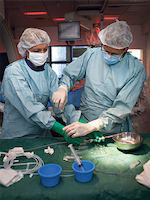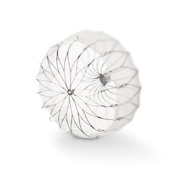Research
The Structural research group is anchored at the Institute for Clinical Medicine, Aarhus University and Aarhus University Hospital.
Our research group is involved in a wide range of both experimental and clinical research within all areas of structural heart disease from model-developing to multicenter randomized controlled trials. Furthermore, we have a proud tradition to evaluate the clinical outcomes by means of high-quality registry studies.
Clinical research
Our clinical research ranges from small prospective studies to large multicenter randomized controlled trials within both safety and effectiveness of devices, diagnostic products and treatment regimes. Furthermore, we are involved in a wide range of registrybased studies in close collaboration with other institutions.
Experimental research
The experimental part of our research is centered around the pulmonary circulation and the right ventricle.
The group works with a variety of disease models in animals, such as the pulmonary trunk banding and sugen hypoxia models in rats as well as the acute pulmonary embolism and CTEPH models in pigs. Most of these models have been developed by the group.
Our experimental research is tied closely to the clinic and many of our studies stem from clinical need and aim to benefit the patients directly.
In our research we use a wide range of imaging technology (e.g. ultrasound, MRI, CT, Dual-Energy CT), ventricular pressure and volume measurements, and tissue analyses. Over the years, we have built strong research collaborations with medical device companies and international research institutions, especially in Amsterdam and Boston.
Most of the experimental research is undertaken by young researchers such as PhD students and Research Year Students as a part of their research education.
Please follow the links for further details about our ongoing studies.
Acute pulmonary embolism
Pulmonary vasodilation in the prolonged phase of acute pulmonary embolism

This study is using our group’s well-established animal model of acute PE in pigs.
We aim to investigate the vasodilatory effects of oxygen and sildenafil in the initial 48 hours after onset of acute PE. Due to this study’s increased length, compared to previous experimental studies, it may possibly characterize a therapeutic window for vasodilator treatment in pulmonary embolism and explain the discrepancy between previous neutral clinical studies and positive experimental studies.
For more information; contact Victor Tang Merit
Other studies
MAGNETO
The objective of this trial is to evaluate the safety and effectiveness of the Amulet LAA occluder compared to NOAC therapy in patients with non-valvular AF at increased risk for ischemic stroke and who are recommended for long-term NOAC therapy.
Aarhus University is currently enrolling patients in the study.
For more information please click here or contact Jens Erik Nielsen-Kudsk
BETULA
The BETULA trial is comparing the efficacy of low dose catheter directed thrombolysis to standard treatment with unfractioned heparin (UFH) in patients with intermediary-high risk pulmonary embolism.
Aarhus University is currently enrolling patients in the study. For more information please contact Asger Andersen or Jacob Gammelgaard Schultz
Chronic thromboembolic pulmonary hypertension (CTEPH)
Dual-energy CT perfusion in acute PE and CTEPH

The project focuses on the use of quantitative lung perfusion data obtained from fully automatic software in acute PE and CTEPH. The software automatically segments lungs, vessels, and iodine contrast (a surrogate for blood volume) from surrounding tissue, and then calculates a large variety of different perfusion parameters. We aim to improve diagnostics and severity assessment of both diseases through clinical and experimental studies.
For more information, contact Jacob Valentin Hansen
Development of a porcine model of CTEPH

CTEPH is a feared complication in survivors of acute pulmonary embolism associated with high mortality. This project aims to develop a model of CTEPH in pigs by inducing repetitive pulmonary emboli and evaluating after one month using CT-scan and invasive pressure and volume measurements. The project will provide novel insights in the pathogenesis of CTEPH and has potential to develop a model of CTEPH in pigs, and hereby create the opportunity to assess new possible treatment options in experimental studies.
For more information, contact Mathilde Emilie Kirk
GO-CTEPH

Go-CTEPH is an investigator-initiated multicenter randomised trial. The aim of the study is to evaluate if balloon pulmonary angioplasty (BPA) if non-inferior to pulmonary endarterectomy (PEA) in patients with chronic thromboembolic pulmonary hypertension.
Gold standard treatment to date is PEA performed by skilled cardio-thoracic surgeons. BPA has been available as an effective treatment since 2015. This will be the first head-to-head comparison of BPA and PEA to be performed.
Left atrial appendage occlusion
Device-related Thrombosis in Left Atrial Appendage Occlusion

In left atrial appendage occlusion, the relationship between device healing and device-related thrombosis remains incompletely understood.
Through this PhD project, we aim to improve understanding of the device endothelization process and risk of device-related thrombosis through histological, biochemical and radiographical characterization. Furthermore, in-vitro and clinical investigation of the hemostatic consequences of device implantation should aid development of safe and effective antithrombotic treatments. Finally, registry-based investigation of the efficacy and safety of current post-procedural antithrombotic approaches may guide clinicians to a better patient management.
For more information, contact Anders Dahl Kramer
Occlusion-AF Trial

Oral anticoagulation with novel oral anticoagulants (NOACs) is the current primary option for stroke prevention in patients with AF, although it increases the risk of major bleeding. Patients with prior ischemic cerebrovascular events are at particularly high risk of both recurrent ischemic events and major bleeding. Left atrial appendage occlusion (LAAO) provides an alternative option for stroke prevention in high-risk patients, however, with currently limited evidence. Thus, randomized trials comparing LAAO to NOACs are needed.
The Occlusion-AF is a multicentre randomized clinical trial comparing LAAclosure with anticoagulant prevention (NOAC) in patients with ischemic stroke or TIA and atrial fibrillation. The study is the first to direct compare effects and safety of LAAO vs NOAC in stroke patients with AF (high risk patients).
The study is supported by the Novo Nordisk foundation.
If you want to know more, please contact Kasper Krohn Korsholm
Other studies
CATALYST

The objective of this trial is to evaluate the safety and effectiveness of the Amulet LAA occluder compared to NOAC therapy in patients with non-valvular AF at increased risk for ischemic stroke and who are recommended for long-term NOAC therapy.
Aarhus University is currently enrolling patients in the study.
For more information please click here or contact Jens Erik Nielsen-Kudsk
CHAMPION-AF

The CHAMPION-AF Clinical trial is studying WATCHMAN FLX as a first choice option versus blood thinners for AFib patients who are able to tolerate long-term blood thinner use, but would consider a one-time, device option for stroke risk reduction.
Patient inclusion was closed in 2022 and the first results are expected in 2025.
Aarhus University is a part of the study.
For more information please click here or contact Jens Erik Nielsen-Kudsk
Right heart failure
Diastolic adaptation and new treatment strategies in right heart failure

Right heart failure is the predominant cause of death in patients with pulmonary arterial hypertension, and yet no direct treatment options of the right heart exist. During my PhD project I investigate the importance of diastolic adaptation in development of right heart failure. With a well-established animal model of isolated right ventricular failure we examine the underlying mechanisms and new potential treatment strategies.
For more information, contact Julie Birkmose Axelsen